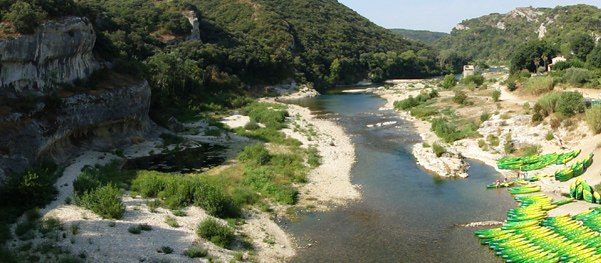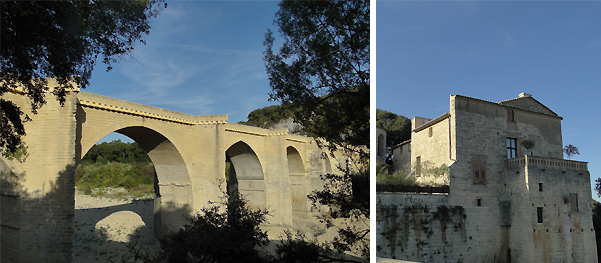The Gardon gorges
 |
|
| The Gardon Gorges – a breathtakingly beautiful site Offering some twenty kilometres of astounding nature, the Gardon Gorges are a true symphony of colours and elements: the emerald green waters, deep green vegetation and milky-white cliffs combine with the blue skies to conjure up beautifully compelling landscapes. The river Gardon has been making its way through the calcareous rocks since times immemorial, carving out a deep winding canyon in the process. The river has always been very unpredictable, at times disappearing, mainly in summer, into ravines and underground galleries to emerge again a few hundred metres further on. Its waters always remain fresh, regardless of how high the outside temperatures are. The Gardon can also be very erratic. Only the imperial Pont du Gard has succeeded in standing up to its floods, which can be as violent as they are sudden. Markers on the Collias bridge show the impressive heights that the waters have reached at times. The site is a Nature reserve, and plays host to a very rich wildlife and rare plants. You may be fortunate enough to spot one of the Bonelli’s eagles which nest in the cliffs, a European beaver or perhaps one of the ten species of bats which come here to reproduce. The exploration of the many caves and cavities has shown that the site has been inhabited since prehistoric times. During the 7th century, the Greek healer Vérédème (the future Bishop of Avignon) retired from the world to live in the Gardon Gorges. The chapel Saint-Vérédeme, backing on to the cliff, at the entrance to a cave, was for a long time a pilgrimage destination. During the same period, Saint Gilles also retired from the world, settling into the Collias hermitage. A number of mills still standing point to area's active past. What activities are available on the Gardon? You can swim of course, and enjoy that all-important nap… There are numerous walking circuits to choose from, either through the canyon itself, or on the wide plateaux either side of the cliffs. The most famous circuit will take you through the cave of Sainte-Baume (ensure you remember to take a torch, and see how many bats you see hanging from the cave's ceiling!). Canoeing is also very popular, with circuits catering for all levels (length and technical difficulty), and, for some of them, the magic of passing under the Pont du Gard. You can also enjoy rock climbing or the Via Ferrata, which provide both thrills and unmatched vantage points. Mountain bike enthusiasts are also spoiled for choice, with 270 km of special trails marked out throughout the region. One of the trails goes through the Gorges' Nature Reserve. |
|
| How to reach the Gorges? - From Collias: this is a very popular beach. If you would prefer a more secluded place, you only have to follow the river banks upstream. A few kilometres up from Collias you will come across the mill of La Baume and the chapel of Saint-Vérédème. Leaving from Sanilhac-Sagriès, there is a marked out circuit which will enable you, leaving from the plateau, to go down into the gorges at the level of the mill and cave of La Baume (the overall gradient is approximately 180m). - From Poulx, on the right bank, you can reach the Gardon on what used to be a passing road (which featured in the classic French film The Wages of Fear [Le Salaire de la Peur]). This also brings you to the Sainte-Baume area and to the Chapel of Saint-Vérédème (the gradient involved is approximately 200 m). Further upstream is the Bridge of Saint-Nicolas. It was severely damaged during the 2002 flooding when the water levels swept over its top, something which is hard to picture in summer when the river actually disappears underground before reappearing further downstream. The Pont Saint-Nicolas is also an ideal place from where to set out for a walk or hike, as is Russan, still further upstream, and whose bridge was also damaged back in 2002. |
|
 |